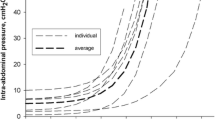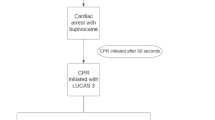Abstract
The effects of pneumoperitoneum with carbon dioxide and helium on systemic hemodynamics and arterial blood gases were investigated in pigs in an attempt to clarify the mechanisms by which pneumoperitoneum may induce organ dysfunction. A total of 16 anesthetized female pigs underwent pneumoperitoneum with carbon dioxide or helium (n=8 each) in a stepwise fashion to intraabdominal pressures of 8, 10, 12, 16, and 20 mmHg. Changes in cardiac output; renal and hepatic blood flow; mean arterial, mean pulmonary arterial, mean pulmonary arterial wedge, inferior vena caval, and portal venous pressures; and total peripheral resistance were measured. Arterial blood samples were obtained at the same time the above parameters were determined. Urine volume was measured as an indicator of renal function. Pneumoperitoneum with either carbon dioxide or helium significantly increased venous pressures and simultaneously decreased cardiac output. These changes were associated with decreases in organ blood flow due to increased peripheral resistance. Urinary output was reduced to a similar degree in the two groups. Blood gas analysis revealed pneumoperitoneum-induced metabolic acidosis in both groups, although hypercapnia was observed only in the carbon dioxide group. These findings suggest that pneumoperitoneum-related organ dysfunction may be due to increased intraperitoneal pressure rather than to hypercapnia.
Similar content being viewed by others
References
Alexander GD, Brown EM (1969) Physiologic alterations during pelvic laparoscopy. Am J Obstet Gynecol 105: 1078–1081
Aukland K, Bower BF, Berliner RW (1964) Measurement of local blood flow with hydrogen gas. Circ Res 14: 164–187
Barnes GE, Laine GA, Giam PY, Smith EE, Granger HJ (1985) Cardiovascular responses to elevation of intra-abdominal hydrostatic pressure. Am J Physiol 248: R208–213
Cohen RD, Woods HF (1976) The clinical presentations and classifications of lactic acidosis. In: Cohen RD, Woods HF (eds) Clinical and biochemical aspects of lactic acidosis. Blackwell, Oxford, p 42
Eisenhauer DM, Saunders CJ, Ho HS, Wolfe BM (1994) Hemodynamic effects of argon pneumoperitoneum. Surg Endosc 8: 315–321
Gattinoni L, Feriani M (1993) Renal disease: acid-base derangements in acute renal failure. In: Pinsky MR, Dhainaut JFA (eds) Pathophysiologic foundations of critical care. Williams & Wilkins, Baltimore, p 619
Harman PK, Kron IL, Mclachlan HD, Freedlender AE, Nolan SP (1982) Elevated intra-abdominal pressure and renal function. Ann Surg 196: 594–597
Hashikura Y, Kawasaki S, Munakata Y, Hashimoto S, Hayashi K, Makuuchi M (1994) Effects of peritoneal insufflation on hepatic and renal blood flow. Surg Endosc 8: 759–761
Ho HS, Gunther RA, Wolfe BM (1992) Intraperitoneal carbon dioxide insufflation and cardiopulmonary functions. Laparoscopic cholecystectomy in pigs. Arch Surg 127: 928–933
Ivankovich AD, Miletich DJ, Albrecht RF, Heyman HJ, Bonnet RF (1975) Cardiovascular effects of intraperitoneal insufflation with carbon dioxide and nitrous oxide in the dog. Anesthesiology 42: 281–287
Kelman GR, Swapp GH, Smith I, Benzie RJ, Gordon NL (1972) Cardiac output and arterial blood-gas tension during laparoscopy. Br J Anaesth 44: 1155–1162
Kitano S, Sugimachi K (1993) Peritoneoscopic cholecystectomy has opened the door to minimally invasive surgery. J Gastroenterol Hepatol 8: 476–482
Kitano S, Tomikawa M, Iso Y, Iwata S, Gondo K, Moriyama M, Sugimachi K (1992) A safe and simple method to maintain a clear field of vision during laparoscopic cholecystectomy. Surg Endosc 6: 197–198
Kitano S, Iso Y, Tomikawa M, Moriyama M, Sugimachi K (1993) A prospective randomized trial comparing pneumoperitoneum and U-shaped retractor elevation for laparoscopic cholecystectomy. Surg Endosc 7: 311–314
Kubota K, Kajima N, Teruya M, Ishihara T, Tsushima H, Ohta S, Nakao K, Arizono S (1993) Alterations in respiratory function and hemodynamics during laparoscopic cholecystectomy under pneumoperitoneum. Surg Endosc 7: 500–504
Lighton TA, Bongard FS, Liu SY, Lee TS, Klein SR (1991) Comparative cardiopulmonary effects of helium and carbon dioxide pneumoperitoneum. Surg Forum 42: 485–487
Marshall RL, Jebson PJR, Davie IT, Scott DB (1972) Circulatory effects of carbon dioxide insufflation of the peritoneal cavity for laparoscopy. Br J Anaesth 44: 680–684
Motew M, Ivankovich AD, Bieniarz J, Albrecht RF, Zahed B, Scommegna A, Silverman B (1973) Cardiovascular effects and acid-base and blood gas changes during laparoscopy. Am J Obstet Gynecol 115: 1002–1012
Nathanson LK, Schimi S, Cuschieri A (1991) Laparoscopic cholecystectomy. The Dundee technique. Br J Surg 78: 155–159
Price HL (1960) Effects of carbon dioxide on the cardiovascular system. Anesthesiology 21: 652–663
Richards WO, Scovill W, Shin B, Reed W (1983) Acute renal failure associated with increased intra-abdominal pressure. Ann Surg 197: 183–187
Richardson JD, Trinkle JK (1976) Hemodynamic and respiratory alterations with increased intra-abdominal pressure. J Surg Res 20: 401–404
Schirmer BD, Edge SB, Dix J, Hyser MJ, Hanks JB, Jones RS (1991) Laparoscopic cholecystectomy, treatment of choice for symptomatic cholelithiasis. Ann Surg 213: 665–677
Shenasky JH, Gillenwater JY (1972) The renal hemodynamic and functional effects of external counterpressure. Surg Gynecol Obstet 134: 253–258
Van den Bos GC, Drake AJ, Noble MI (1979) The effect of carbon dioxide upon myocardial contractile performance, blood flow and oxygen consumption. J Physiol (Lond) 287: 149–161
Williams MD, Murr PC (1993) Laparoscopic insufflation of the abdomen depresses cardiopulmonary function. Surg Endosc 7: 12–16
Author information
Authors and Affiliations
Rights and permissions
About this article
Cite this article
Shuto, K., Kitano, S., Yoshida, T. et al. Hemodynamic and arterial blood gas changes during carbon dioxide and helium pneumoperitoneum in pigs. Surg Endosc 9, 1173–1178 (1995). https://doi.org/10.1007/BF00210922
Received:
Accepted:
Issue Date:
DOI: https://doi.org/10.1007/BF00210922




